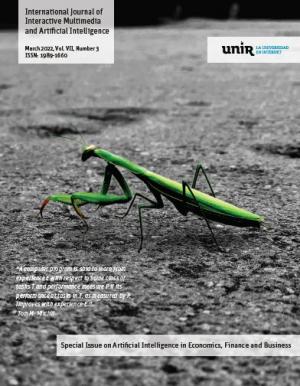Using Customer Knowledge Surveys to Explain Sales of Postgraduate Programs: A Machine Learning Approach.
DOI:
https://doi.org/10.9781/ijimai.2022.01.008Keywords:
Business Intelligence, Business Analytics, Business Decision Making, Clustering, Machine LearningAbstract
Universities collect information from each customer that contacts them through their websites and social media profiles. Customer knowledge surveys are the main information-gathering tool used to obtain this information about potential students. In this paper, we propose using the information gained via surveys along with enrolment databases, to group customers into homogeneous clusters in order to identify target customers who are more likely to enroll. The use of such a cluster strategy will increase the probability of converting contacts into customers and will allow the marketing and admission departments to focus on those customers with a greater probability of enrolling, thereby increasing efficiency. The specific characteristics of each cluster and those postgraduate programs that are more likely to be selected are identified. In addition, better insight into customers regarding their enrolment choices thanks to our cluster strategy, will allow universities to personalize their services resulting in greater satisfaction and, consequently, in increased future enrolment.
Downloads
References
R. M. C. Croda, D. E. G. Romero, F. R. C. Villar, “The promotion of graduate programs through clustering prospective students,” International Journal of Interactive Multimedia and Artificial Intelligence, vol. 5, no. 6, pp. 23-32, 2019, doi: 10.9781/ijimai.2019.07.001.
C. Dimartino, and S. B. Jessen, “Selling school: The marketing of public education,” Teachers College Press, 2018.
M. Coccoli, A. Guercio, P. Maresca, and L. Stanganelli, “Smarter universities: A vision for the fast changing digital era,” Journal of Visual Languages & Computing, vol. 25, no. 6, pp. 1003-1011, 2014.
D-E. Gibaja-Romero, “Interacciones en economías de plataformas,” in Perspectivas de la Industria 4.0, AlfaOmega, 2019.
A. S. S. Tota, and M. C. U. Aguirre, “Marketing digital en universidades privadas en el estado Zulia,” Poliantea vol. 13, no. 24, pp. 5-26, 2017.
M. Yadav, “Social media as a marketing tool: Opportunities and challenges,” Indian Journal of Marketing, vol. 47, no. 3, pp. 16-28, 2017.
D. Vergidis, and C. Panagiotakopoulos, “Student Dropout at the Hellenic Open University: Evaluation of the Graduate Program, Studies in Education,” The International Review of Research in Open and Distributed Learning, vol. 3, no. 2, 2002.
D. Airey, and D. P. Stergiou, “Returning to education: A stressful experience?,” in Lifelong Learning for Tourism, Routledge, pp. 51-69, 2017.
A. Yasmin, S. Tasneem, and K. Fatema, “Effectiveness of digital marketing in the challenging age: An empirical study,” International Journal of Management Science and Business Administration, vol. 1, no. 5, pp. 69-80, 2015.
J. Avorn, “Academic detailing: “marketing” the best evidence to clinicians,” Jama, vol. 317, no. 4, pp. 361-362, 2017.
F. Pucciarelli and A. Kaplan, “Competition and strategy in higher education: Managing complexity and uncertainty,” Business Horizons, vol. 59, no. 3, pp. 311-320, 2016.
M. E. M. Rosay, “La deserción en el posgrado: estudio comparativo entre maestristas de una universidad pública y privada,” in Congresos CLABES, 2017.
G. R. Johnson, C. Jubenville, and B. Goss, “Using institutional selection factors to develop recruiting profiles: Marketing small, private colleges and universities to prospective student athletes,” Journal of Marketing for Higher Education, vol. 19, no. 1, pp. 1-25, 2009.
R. Pizarro-Milian, “What’s for sale at Canadian Universities? A mixed-methods analysis of promotional strategies,” Higher Education Quarterly, vol. 71, no. 1, pp. 53-74, 2017.
C. Lubienski, “Marketing schools: Consumer goods and competitive incentives for consumer information,” Education and Urban Society, vol. 40, no. 1, pp. 118-141, 2007.
K.K. Tsiptsis and A. Chorianopoulos, “Data mining techniques in CRM: inside customer segmentation” in John Wiley & Sons. 2011.
C. Marcus, “A practical yet meaningful approach to customer segmentation”, Journal of consumer marketing, 2008.
R. S. Wu and P. H. Chou, “Customer segmentation of multiple category data in e-commerce using a soft-clustering approach,” Electronic Commerce Research and Applications, vol. 10, no. 3, pp. 331-341, 2011.
R. Burkholz, “Entwicklung einer Buyer Persona,” in Marketing and Sales Automation (pp. 49-58). Springer Gabler, Wiesbaden, 2017.
A. Revella, “Buyer personas: how to gain insight into your customer’s expectations, align your marketing strategies, and win more business,” In John Wiley & Sons, 2015.
L. Rokach and O. Maimon, “Clustering methods” in Data mining and knowledge discovery handbook (pp. 321-352). Springer, Boston, MA, 2005.
A. Bhat, “K-medoids clustering using partitioning around medoids for performing face recognition” International Journal of Soft Computing, Mathematics and Control, vol. 3, no. 3, pp. 1-12, 2014.
L. Van der Maaten and G. Hinton, “Visualizing data using t-SNE” Journal of machine learning research, vol. 9, no. 11, 2008.
Downloads
Published
-
Abstract232
-
PDF45









